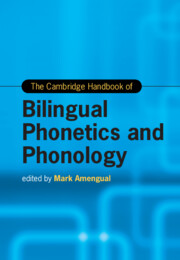Book contents
- The Cambridge Handbook of Bilingual Phonetics and Phonology
- Cambridge Handbooks in Language and Linguistics
- The Cambridge Handbook of Bilingual Phonetics and Phonology
- Copyright page
- Dedication
- Contents
- Figures
- Tables
- Contributors
- Acknowledgments
- Introduction Bilingual Phonetics and Phonology
- Part I Approaches to Bilingual Phonetics and Phonology
- Part II Theoretical Models of Bilingual Phonetics and Phonology
- Part III The Phonetics and Phonology of the Bilingual Child
- Part IV The Phonetics and Phonology of the Bilingual Adult
- 17 The Speech Perception of Bilingual Adults
- 18 The Speech Production of Bilingual Adults
- 19 Phonological Processing and Lexical Encoding in Bilingual Speech
- 20 Acquisition of Segmental Phonology in Adult Bilingualism
- 21 Acquisition of Suprasegmental Phonology in Adult Bilingualism
- Part V The Diversity of Bilingual Speakers
- Part VI Variables and Outcomes of Bilingual Speech
- Index
- References
18 - The Speech Production of Bilingual Adults
from Part IV - The Phonetics and Phonology of the Bilingual Adult
Published online by Cambridge University Press: 14 November 2024
- The Cambridge Handbook of Bilingual Phonetics and Phonology
- Cambridge Handbooks in Language and Linguistics
- The Cambridge Handbook of Bilingual Phonetics and Phonology
- Copyright page
- Dedication
- Contents
- Figures
- Tables
- Contributors
- Acknowledgments
- Introduction Bilingual Phonetics and Phonology
- Part I Approaches to Bilingual Phonetics and Phonology
- Part II Theoretical Models of Bilingual Phonetics and Phonology
- Part III The Phonetics and Phonology of the Bilingual Child
- Part IV The Phonetics and Phonology of the Bilingual Adult
- 17 The Speech Perception of Bilingual Adults
- 18 The Speech Production of Bilingual Adults
- 19 Phonological Processing and Lexical Encoding in Bilingual Speech
- 20 Acquisition of Segmental Phonology in Adult Bilingualism
- 21 Acquisition of Suprasegmental Phonology in Adult Bilingualism
- Part V The Diversity of Bilingual Speakers
- Part VI Variables and Outcomes of Bilingual Speech
- Index
- References
Summary
Adults undertaking the endeavor of learning a new language can attest to the difficulty involved with producing the sounds and prosody of the target language. A principal aim of research on adult speech production is to comprehend the mechanisms and processes that differentiate adult bilingual speech development from bilingual speech that develops earlier in life. It is clear that individuals who learn an additional language in adulthood typically encounter some difficulties that early learners do not. In particular, these difficulties arise at the segmental level when acquiring novel sound categories and novel sound contrasts, as well as at the suprasegmental level when learning to produce non-native prosodic structures related to intonation, stress, rhythm, tone, and tempo. The present chapter provides a selective overview of the current state-of-the-art in adult bilingual speech production. Furthermore, this chapter considers theoretical and methodological areas for improvement, as well as avenues for future research.
Keywords
- Type
- Chapter
- Information
- The Cambridge Handbook of Bilingual Phonetics and Phonology , pp. 407 - 425Publisher: Cambridge University PressPrint publication year: 2024

